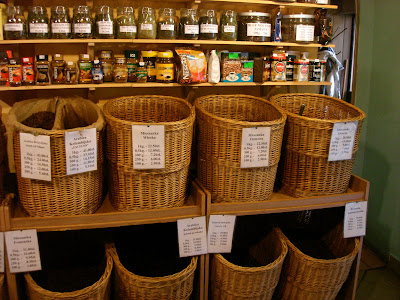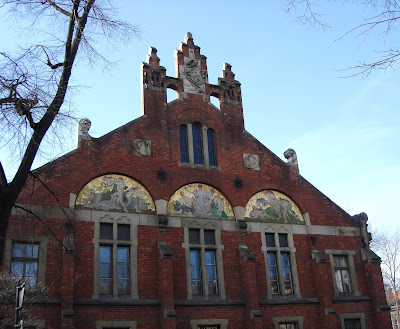 Poznan's "Stary Rynek" (old town square)
Poznan's "Stary Rynek" (old town square)With our time in Poland running short, we decided to take one last trip. Poznan is considered one of the “must see” cities in Poland, so we couldn’t leave without a visit. The title of this post is from the earliest known depiction of Poznan ("Posnania elegans Poloniae civitas") and it is a beautiful city. We didn't arrive with any particular expectations and were very impressed with how vibrant this city is. From the pictures you might think that these Polish cities and their town squares and churches all look the same, but that’s not the case. Though the buildings here reminded us of some in Lublin, Poznan’s are in much better repair and the square itself is very lively. (As one tour book put it, being there reminds one of what a great idea a town square is.) All those decorations you see on the buildings aren't just painted on - they're actually different layers of plaster…it’s amazing. (I've learned that this is called "sgraffito," a technique of wall decor produced by applying layers of plaster tinted in contrasting colors to a moistened surface.)
 The Town Hall, in the middle of the Rynek
The Town Hall, in the middle of the Rynek View of the Rynek from our hotel room
View of the Rynek from our hotel room.JPG) Sgraffito detail on a few of the buildings on the Rynek
Sgraffito detail on a few of the buildings on the Rynek
We had about a 2 km walk from the train station to our hotel on the square (the weather was nice and after a 7 ½ hour train ride from Krakow, we needed a walk). We couldn’t believe all the activity… it’s a college town with lots of young people and the economic prosperity here is evident – Poznan is where all the Polish trade fairs are held and the city council (housed in a lovely building - see below) must be doing its job. [When we met with the Public Relations Officer at the US Consulate in Krakow, she explained to us that some cities in Poland have been very aggressive in attracting new businesses by simplifying their traditional bureaucratic – and long - process of applications and permits. As a result, foreign companies that want to locate in Poland, or elsewhere in Eastern Eurpose, end up going to a city such as Wroclaw or Poznan.] They have a shopping mall, built in a huge old brewery that was renovated and expanded with very tasteful, modern connections and additions that is just amazing. (And we don’t particularly like shopping malls. As John said, “Compared to our mall at home, it makes us look like we live in the back woods.”)
 The buildings housing the city government offices
The buildings housing the city government officesPoznan is in western Poland, on the main train route from Berlin to Moscow. For many years it was part of Prussia or Germany and was known as Posen. However, as the inscription of the town indicates (and which modern Poznan has adopted as its slogan), the citizens have long viewed themselves as Polish. In fact, legend has it that the Polish nation was founded on the Warka River island in the center of Poznan (now the Cathedral Island) when three Slav brothers (Lech, Czech and Rus) met after not seeing each other for a long time and the city was named to commemorate their reunion – “poznac” being Polish for “to meet.” A castle was built on the island in the 9th century and by the 10th century it had become a major center of the Piast state. The first Polish cathedral was built here in 968!
 The Basilica of Saints Peter and Paul on Cathedral Island
The Basilica of Saints Peter and Paul on Cathedral Island Back view of the Basilica
Back view of the BasilicaOne of the buildings on the square is famous for holding Polish culture and language soirees during the Partition years, when all things Polish were banned. After WWI an uprising in Poznan won brief freedom for the region until 1939 when the Nazis rolled in, wiped out the city’s many Jews and killed or displaced much of the Polish population. After WWII, Poznan was in the area that was taken from Germany and given to Poland (as partial compensation for the large eastern chunk of Poland that the Soviet Union took). In 1956 Poznan was the site of a food riot in which 76 people were killed but led to a political “thaw” which many believe enabled the later formation of Solidarity and the eventual overthrow of the Communist government in 1989. Today Poznan is a thriving city of about 580,000.
 Our hotel (and brew pub on the ground floor) on the Rynek
Our hotel (and brew pub on the ground floor) on the Rynek The monument to the victims of the Poznan food riots of 1956.
The monument to the victims of the Poznan food riots of 1956.


.JPG)



 Monika Sady, my main contact at the University
Monika Sady, my main contact at the University

 St. Mary's Church on the Rynek - one of the symbols of Krakow
St. Mary's Church on the Rynek - one of the symbols of Krakow



.JPG)































.JPG)



